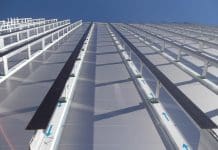Edmund Wilkinson, head of sales for in-building solutions at Cellnex UK, explores how enhanced connectivity is crucial for ensuring our buildings meet the expectations of an increasingly digital workforce
Technologies such as artificial intelligence (AI) and Internet of Things (IoT) have put pressure on the workplace to evolve and keep pace with digital transformation.
In the last few years in particular, the move to hybrid working has seen office layouts shaken up, with hot desks and more mobile working.
This has resulted in a shift away from traditional IT environments, adopting technologies like collaboration tools and cloud infrastructure, meaning the demand for enhanced connectivity has never been greater.
Ensuring offices are built with a digital focus
According to JLL’s The Future of the Work survey, 72% of respondents agree that in the long term, the office will remain central to their organisation’s ecosystem. Therefore, we need to ensure our office spaces are adapted or built with a digital focus in mind.
In a modern working environment, connectivity supports the wellbeing and engagement of employees, enabling staff to work remotely while continuing to collaborate with colleagues.
It’s safe to say a strong employee experience drives a range of strategic benefits, with MIT reporting that companies who prioritise this are 25% more profitable.
Similarly, they also have twice the level of innovation and double the customer satisfaction (NPS scores). For building tenants, enhancing productivity, attracting the best talent and boosting profits hinges on workspaces being designed with a flexible, diverse and tech-enabled workforce in mind.
It’s clear that employers, or building tenants, are turned on to the fact that smart spaces with enhanced connectivity can empower their workforce and help them remain competitive.
However, for landlords of old buildings, struggling to compete against newer modern spaces with the latest technology, it can feel like an uphill struggle.
Some 43% of organisations expect that they will need more outsourcing support for Commercial Real Estate (CRE) technology solutions over the next three years.
Creating a smart workplace
Typically, older buildings have thick concrete walls, complex layouts with obstructions and few electric sockets for plugging in Wi-Fi routers. Older infrastructure therefore interferes with Wi-Fi and broadband, which can lead to reduced network performance and connectivity issues.
Designing new buildings or retrofitting existing workplaces with In-Building connectivity solutions will solve this issue, with Distributed Antenna Systems (DAS) providing enhanced cellular coverage.
This connectivity extends the reach of wireless networks to offer reliable and consistent connections that can handle the high levels of data traffic that occur in workplaces.
While it’s true that workplaces offer free Wi-Fi, this isn’t the ideal solution for all employees’ needs, with concerns around incoming and outgoing phone calls, buffering on video calls and employees unable to access files which are stored on the cloud or a VPN.
Workplace buildings can provide a truly seamless experience by eliminating the need for employees to connect to Wi-Fi via access codes and logon processes each time they enter the building. They can stay connected from the moment they enter the building without disruption or experiencing slower speeds when re-entering the workplace.
By strategically placing antennas throughout the premises, DAS overcomes the limitations posed by thick walls and structural obstacles, ensuring strong, consistent, and cost-effective connectivity for building users.
The benefits of enhanced connectivity in workplaces
Digital workplaces bring benefits for both organisations and their employees:
- Flexible working: Having seamless connectivity is an enabler for hybrid and remote working arrangements. Allowing employees to work from anywhere, and in their own time, will improve work-life balance and increase employee retention.
- Collaboration: Video conferencing, instant messaging and document sharing make it easier for employees to work together regardless of their location. In addition, organisations are using remote cloud-based software to store and access data or files to enhance employee efficiency by storing information in one place.
- Innovation: Organisations are increasingly using digital transformation tools, such as AI, machine learning (ML), automation and virtual reality to create and develop new products, and services which allow them to stay ahead of their competition.
- Sustainability: In-building connectivity solutions enable the implementation of IoT smart building solutions, including using sensors, automation and real-time data to optimise lighting, heating and air conditioning (HVAC), which reduces energy consumption and contributes to an organisations CO2 saving.
In workplaces, In-Building connectivity is helping to upgrade the usability of a space, from energy saving initiatives, to supporting a tech-enabled workforce and enhancing employee productivity to boost profits.
Buildings with a digital-focused design will also support the industry with increasing occupancy rates and maximising the value of the property.
Edmund Wilkinson
Head of sales for in-building solutions
Cellnex UK In-Building Solutions














